Estimated cost for Oak Harbor’s sewage treatment plant under construction in Windjammer Park recently jumped by $20 million.
The Oak Harbor mayor and city council members were surprised to learn from city staff that the estimated price tag is now $142 million, according to a statement from the city. The estimate was at $122 million in September 2016.
The increase, however, won’t affect the current monthly sewage rate for customers, which is $102 a month, or change projected increases for future years. In fact, the latest estimates show the projected rates decreasing slightly; the projected rate for 2021 is $110.08, according to City Administrator Doug Merriman.
This isn’t the first time the cost of the project escalated. In 2015, the cost estimates increased from the original $79 million to $116 million. As a result, council members vowed to keep a closer watch on the project and asked staff to give updates at every council meeting.
Mayor Bob Severns said he is “upset and concerned” by the recent revelation and promised to investigate.
“The Mayor has serious concerns,” a statement from the city reads, “about both the substantial increases in projected costs from earlier estimates as well as the lack of communication about these increased cost estimates that should have been provided to both the Mayor and City Council from persons responsible for monitoring this project.”
Severns said he will be conducting an “intense review” of city departments responsible for monitoring the costs of the project. That includes the city administrator, the city engineer and public works, the statement says.
The mayor said he has also initiated an independent audit and review of the sewage treatment plant costs and the manner in which those costs were monitored and reported. The audit will be done by an outside company.
City Councilman Rick Almberg said the council and mayor are also to blame for not keeping abreast of the costs.
“Elected officials have the responsibility to ask questions and demand answers,” he said.
Almberg, who’s been closely monitoring the project, explained that the staff provided council members with a summary of the total cost estimate in September 2016. They didn’t provide any total cost summaries after that — as the numbers ballooned — but council members were given updated costs of different packages and could have added the numbers themselves, he said.
“I’m still convinced we have a good team in place,” he said. “I’m still convinced we will have a state-of-the-art facility that will serve the community for 40-50 years at an affordable rate.”
Merriman explained that the treatment plant is funded “through a combination of State Revolving Fund low-interest-rate loans, grants and revenue bonds.”
“The funding package includes approximately $8.5 million in grants not requiring payback, approximately $97 million dollars in reduced rate loans, some as low as 1.2 percent,” he wrote in an email.
Early on, the city had the opportunity to retain revenue bonds at 6 percent. Instead, city officials decided to pursue lower-interest loans from the state. The result is that taxpayers, through the existing funding package, “will save approximately $116 million in principal and interest costs over the life of the funding package,” Merriman said.
These savings are the reason that sewage rates aren’t increasing for residents beyond projections despite the escalation in the project’s cost.



